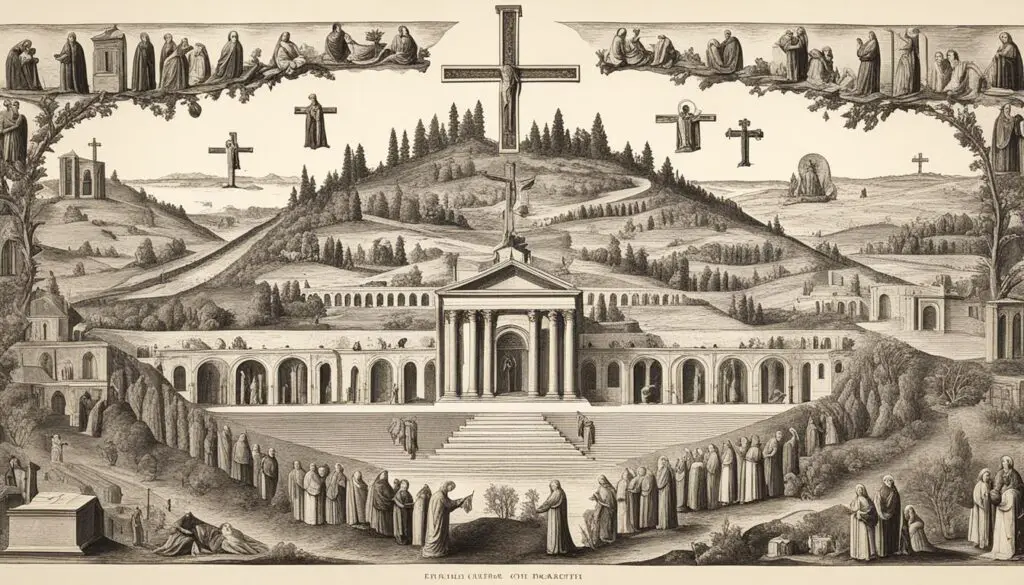Contemplative prayer, also known as centering prayer, has a rich and fascinating history within the Christian contemplative tradition. Its origins can be traced back to the 3rd century when it was practiced by the Desert Mothers and Fathers, Christian hermits and monks living in the Egyptian desert. Today, contemplative prayer practices continue to evolve and attract individuals from various denominations who are seeking a deeper connection with God.
Key Takeaways:
- The history of contemplative prayer dates back to the 3rd century when it was practiced by the Desert Mothers and Fathers.
- Contemplative prayer is also known as centering prayer and involves stilling the mind and connecting with the love and presence of God.
- Various influential figures and ancient texts have contributed to the development and understanding of contemplative prayer in the Christian tradition.
- The revival of contemplative prayer in the modern era has led to the widespread practice of centering prayer by Christians of different denominations.
- Contemplative prayer is not limited to a specific branch of Christianity and is embraced by Catholics, Eastern Orthodox, and Protestants.
Ancient Origins of Christian Contemplation
The history of contemplative prayer in the Christian tradition can be traced back to ancient times. In the 3rd century, Desert Mothers and Fathers practiced silent, imageless, contemplative prayer as a way to encounter the divine. The 14th-century book, “The Cloud of Unknowing,” written by an anonymous monk, further emphasized the importance of contemplation in the Christian tradition. Other influential figures include John Cassian, Dame Julian of Norwich, St. Teresa of Avila, and St. John of the Cross. These individuals contributed to the development of meditation techniques and the exploration of ancient prayer traditions that continue to shape contemplative prayer practices today.
Christian mysticism has deep roots in the contemplative prayer practices of the past. By stilling their minds and embracing silence, the Desert Mothers and Fathers sought to connect with the divine in a profound way. Their wisdom and practices have been passed down through the centuries, influencing the development of Christian contemplation.
“The Cloud of Unknowing” teaches us to let go of our thoughts and images during prayer and simply rest in God’s presence. It reminds us that the true experience of God transcends human understanding.
Anonymous Monk
These ancient prayer traditions explore the depths of spirituality in meditation and offer guidance to those on the path of contemplation. They encompass various meditation techniques that provide individuals with the means to enter into a state of deep connection with the divine.
Ancient Prayer Traditions
| Ancient Prayer Traditions | Description |
|---|---|
| Desert Mothers and Fathers | Ancient Christian hermits and monks who practiced silent, imageless contemplative prayer. |
| “The Cloud of Unknowing” | A 14th-century book that emphasizes the importance of contemplation and letting go of thoughts during prayer. |
| John Cassian | Ancient Christian theologian who explored contemplative practices and developed the concept of “purifying the heart”. |
| Dame Julian of Norwich | An English mystic who wrote about her profound experiences of God’s love and visions. |
| St. Teresa of Avila | A Spanish mystic who established the Discalced Carmelites and wrote extensively on the stages of the contemplative journey. |
| St. John of the Cross | A Spanish mystic and poet who delved into the themes of spiritual purification and divine union in his writings. |
These ancient prayer traditions form the foundation of Christian contemplation and provide valuable insights into the practice. By studying their teachings and incorporating their wisdom into our lives, we can deepen our spiritual connection and experience the transformative power of contemplative prayer.
Revival of Contemplative Prayer in the Modern Era
After centuries of relative dormancy, the contemplative prayer tradition experienced a revival in the 20th century. Trappist monks, led by Abbott Thomas Keating, sought to reconnect with Christianity’s contemplative roots and developed the practice of centering prayer. This simple yet profound method of prayer gained popularity and was described in detail in Father Keating’s book, “Open Mind, Open Heart.”
Today, centering prayer is practiced widely by ordinary Christians, both Catholic and Protestant. It has become a key aspect of monastic prayer practices and is embraced by individuals seeking a deeper, more mindful connection to God.
Centering prayer involves finding a quiet space, sitting comfortably, and focusing one’s attention on a sacred word or phrase, such as “peace” or “be still.” By gently returning to the sacred word whenever distractions arise, practitioners cultivate a state of deep presence and openness to the divine.
“Centering prayer is not so much a technique as a way of cultivating a relationship with God, of being with God beyond concepts, words, and images. It is a practice of surrender and trust, allowing God to work within us in ways that transcend our understanding.” – Abbott Thomas Keating
This contemplative approach to prayer encourages individuals to let go of thoughts, worries, and expectations, and to rest in the awareness of God’s presence. It provides a pathway to inner stillness, peace, and unity with the divine.
Through the revival of contemplative prayer in the modern era, individuals have rediscovered the profound spiritual benefits of this ancient practice. In a fast-paced world filled with distractions and noise, centering prayer offers a sanctuary of silence and a means of nourishing the soul.

| Benefits of Revived Contemplative Prayer | Explanation |
|---|---|
| Enhanced Mindfulness | Practitioners develop a heightened sense of mindfulness, cultivating deep awareness of the present moment and the divine presence within. |
| Stress Reduction | The practice of centering prayer offers a respite from the pressures of daily life, allowing individuals to experience relaxation and inner peace. |
| Spiritual Connection | Contemplative prayer provides a means of forging a deeper, more intimate relationship with God, fostering a sense of spiritual connection and transformation. |
| Self-Reflection and Discernment | The practice of centering prayer facilitates self-reflection and discernment, allowing individuals to gain clarity and insight into their lives and spiritual journey. |
As more individuals embrace the power of contemplative prayer, it continues to evolve and adapt, nourishing the souls of those who seek a deeper understanding of themselves and their connection to the divine.
Christian Contemplation in Different Traditions
Christian contemplation is not limited to a specific branch of Christianity. Various traditions within Catholicism, Eastern Orthodoxy, and Protestantism have embraced contemplative practices.
In Western Catholicism, the Rule of St. Benedict and the practice of the Divine Office have been central to monastic spirituality. These practices involve structured prayer, meditation, and the chanting of psalms.
Eastern Orthodox monasticism has emphasized Hesychasm, stillness, and the Jesus Prayer as pathways to encountering God. Hesychasm involves deep inner stillness and the use of repetitive prayer, such as the Jesus Prayer: “Lord Jesus Christ, Son of God, have mercy on me, a sinner.”
The Quaker tradition within Protestantism also embraces contemplative prayer. Quakers emphasize silence and inner stillness as a means of experiencing the Inner Light, which they believe is the direct presence and guidance of God in their lives.
Each tradition has its unique language and practices, but they all share a common goal of deepening spiritual connection and transformation through contemplation.

Contemporary Voices in the Christian Contemplative Tradition
In recent times, several influential voices have contributed to the contemporary understanding and practice of Christian contemplation. Among them is Thomas Merton, a renowned Trappist monk who dedicated his life to exploring contemplative practices and fostering dialogue with mystics from different religious traditions. His profound insights and writings continue to inspire and guide individuals on their contemplative journeys.
An important movement that has played a significant role in making contemplative prayer accessible to laypersons is the Centering Prayer movement, founded by Thomas Keating. This movement offers a framework for individuals to engage in the practice of centering prayer, which focuses on stillness and openness to the presence of God within.
“Contemplation is the highest expression of man’s intellectual and spiritual life. It is that life itself, fully awake, fully active, fully aware that it is alive. It is a spiritual wonder. It is spontaneous awe at the sacredness of life, of being. It is gratitude for life, for awareness, and for being.”
– Thomas Merton
In addition to Thomas Merton and the Centering Prayer movement, there are numerous modern contemplative writers who have made significant contributions to the accessibility and understanding of contemplative prayer. Some notable names include Basil Pennington, Cynthia Bourgeault, David Frenette, Richard Rohr, and many others. Each brings unique perspectives and insights that enrich the contemplative landscape and provide individuals with valuable resources for deepening their spiritual practice.
These contemporary voices continue to shape and inspire the Christian contemplative tradition, bridging the gap between ancient wisdom and the modern seeker. Through their writings, teachings, and personal experiences, they invite individuals to explore the transformative power of contemplation and embrace its potential for spiritual growth and awakening.

Conclusion
The history of contemplative prayer is a testament to its enduring relevance and transformative power. From its ancient origins in the practices of the Desert Mothers and Fathers to its revival in the modern era, contemplative prayer has provided individuals with a profound way to connect with God on a deep, personal level.
Today, contemplative prayer continues to evolve, with new voices and practices emerging within the Christian contemplative tradition. The rich tapestry of contemplative prayer is woven across various traditions within Christianity, including Catholicism, Eastern Orthodoxy, and Protestantism, each offering unique approaches to stilling the mind, cultivating inner stillness, and encountering the divine.
Those who explore this ancient and powerful form of prayer often discover a sense of peace that permeates their lives, a stillness that calms the chaos of the external world, and a spiritual growth that surpasses worldly achievements. Contemplative prayer transcends time and tradition, serving as a guide for seekers of God’s presence in their lives.
As the practice of contemplative prayer continues to breathe new life into the hearts and minds of believers, it invites individuals to embark on a journey of self-discovery, deeper intimacy with God, and a renewed sense of purpose. Whether practiced in the solitude of a quiet room, within the sacred walls of a monastery, or in the midst of daily life, contemplative prayer offers a pathway to encounter the divine and nurture one’s soul.
FAQ
What is contemplative prayer?
Contemplative prayer, also known as centering prayer, is a practice rooted in the Christian contemplative tradition. It involves stilling the mind and consenting to the love, presence, and action of God within during periods of prayerful reflection.
Where does the history of contemplative prayer originate?
The history of contemplative prayer can be traced back to the 3rd century when it was practiced by the Desert Mothers and Fathers, Christian hermits and monks living in the Egyptian desert.
How has contemplative prayer been revived in the modern era?
In the 20th century, Trappist monks led by Abbott Thomas Keating sought to reconnect with Christianity’s contemplative roots and developed the practice of centering prayer. This simple yet profound method of prayer gained popularity and is now widely practiced by Christians of various denominations.
Is contemplative prayer limited to a specific branch of Christianity?
No, contemplative prayer is embraced by various traditions within Catholicism, Eastern Orthodoxy, and Protestantism. Each tradition has its unique language and practices but shares a common goal of deepening spiritual connection and transformation through contemplation.
Who are some influential voices in the contemporary understanding of contemplative prayer?
Some influential voices include Thomas Merton, founder of the Centering Prayer movement, as well as writers like Basil Pennington, Cynthia Bourgeault, and Richard Rohr, who have made significant contributions to the accessibility and understanding of contemplative prayer in the present day.
What can contemplative prayer offer to individuals?
Contemplative prayer allows individuals to find a sense of peace, stillness, and spiritual growth that transcends time and tradition, providing a deeper connection with God.








